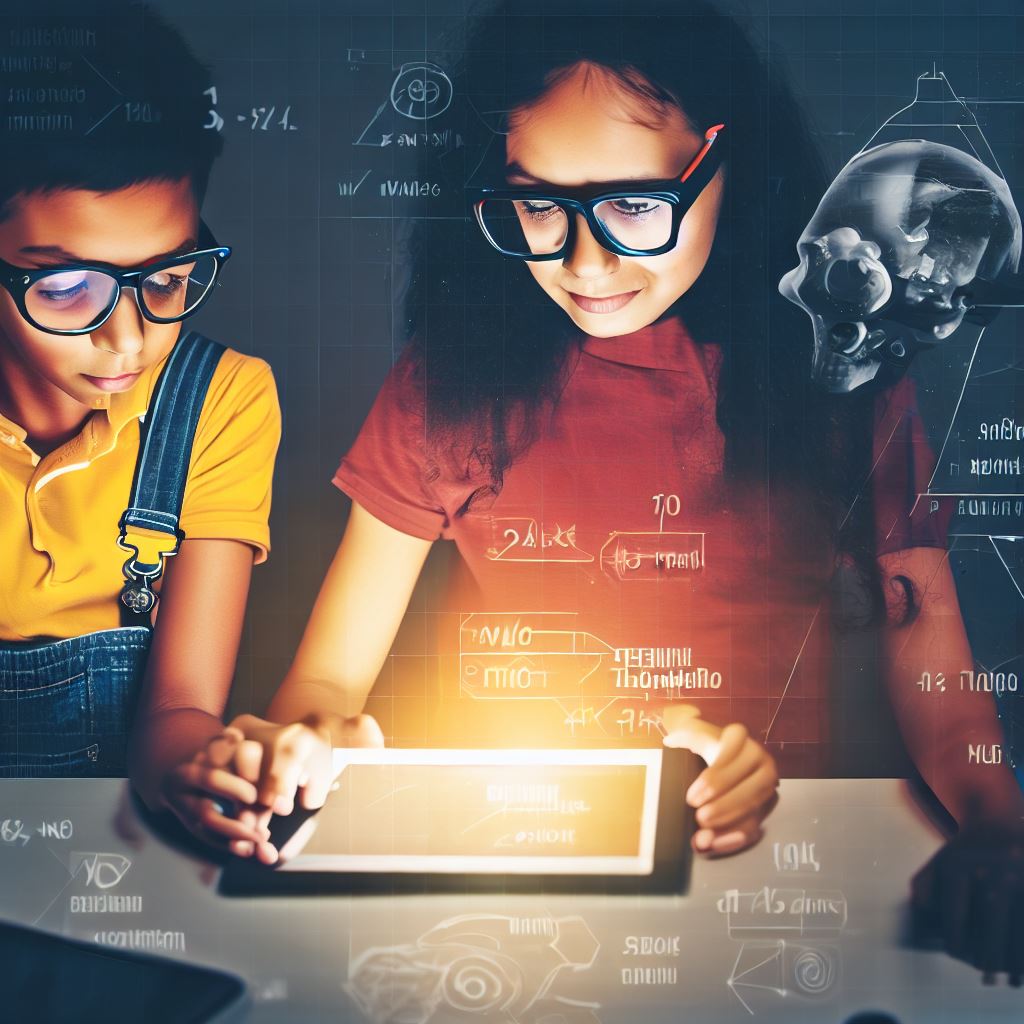Exploring Mathematics and Science Through Scratch
Last Updated on September 20, 2023
Introduction
In today’s digital age, the use of programming languages like Scratch has become increasingly significant in education.
Scratch is a block-based visual programming environment designed to introduce children to coding.
Its user-friendly interface allows students to create interactive stories, games, and animations, nurturing their creativity and problem-solving skills.
While Scratch may seem like a creative outlet, it also presents an opportunity to explore and integrate mathematics and science concepts.
By combining coding with mathematics and science, students can gain a deeper understanding of these subjects while enhancing their computational thinking abilities.
Mathematics plays a vital role in understanding and solving problems in various fields.
Through Scratch, students can develop mathematical thinking by employing logical reasoning, pattern recognition, and algorithmic thinking.
Additionally, they can explore concepts such as coordinates, variables, angles, and geometric shapes, enabling them to create visually appealing and mathematically accurate projects.
Similarly, science is an essential part of our everyday lives, and Scratch provides a platform to engage students in scientific phenomena.
By simulating experiments, students can understand concepts like motion, forces, electricity, and even complex systems like ecosystems.
Scratch allows them to observe cause-effect relationships and test scientific hypotheses in a safe and interactive environment.
By integrating mathematics and science through Scratch, students not only strengthen their computational skills but also develop a deeper understanding and appreciation for these subjects.
As educators, it is crucial to recognize the potential of Scratch in fostering creativity, critical thinking, and problem-solving skills while also reinforcing mathematical and scientific concepts.
Understanding Scratch
Scratch is a visual programming language that allows users to create interactive projects. Its user-friendly interface makes it easy for beginners to learn and experiment with coding.
Scratch is versatile and can be used to create animations, games, and other interactive experiences.
Educators have embraced Scratch because of its effectiveness in teaching computational thinking and problem-solving skills.
Its popularity among educators has led to the development of a large and supportive online community.
Scratch’s user-friendly interface and versatility in creating interactive projects
Scratch’s block-based programming system enables users to build projects by snapping together blocks of code. The visual nature of Scratch makes it engaging and accessible for learners of all ages.
It encourages creativity and allows users to express themselves through programming. Scratch promotes collaboration by allowing users to share their projects and remix others’ work.
Users can access Scratch through a web browser, making it widely accessible, and they can also find extensive online resources, including tutorials, forums, and project galleries.
Scratch serves as a stepping stone for learners to transition into more advanced programming languages, making coding enjoyable by offering immediate results of their work.
With its drag-and-drop interface, Scratch eliminates the need to memorize complex syntax, as its visual blocks represent various programming concepts, facilitating easy understanding and application.
Scratch’s popularity among educators
Scratch’s user-friendly design encourages exploration and experimentation with coding concepts.
As more educators recognize Scratch’s ability to engage students in STEM learning, its popularity has grown, empowering students to become creators and problem solvers rather than passive consumers of technology.
Scratch enables students to practically apply mathematical and scientific concepts, fostering hands-on learning and encouraging critical thinking through its interactive nature.
Scratch supports interdisciplinary learning by combining coding with math and science concepts, allowing students to create projects in various scientific disciplines.
Students can utilize Scratch as a platform to effectively demonstrate their understanding of mathematical and scientific principles.
Its user-friendly interface ensures accessibility for students with diverse backgrounds, lowering barriers to entry.
Scratch’s versatility allows students to personalize their projects and explore their own interests and passions.
Students can develop problem-solving, creativity, and logical thinking skills through Scratch. Furthermore, it supports the development of crucial computational thinking skills for the future workforce.
The popularity of Scratch has motivated educators to create offline materials and curriculum resources, fostering computational thinking and systematic problem-solving in students.
Scratch’s interactive projects tangibly represent students’ learning and progress. Furthermore, it fosters a positive, inclusive learning environment that promotes collaboration and mutual support among students.
Scratch motivates students to persist in their learning and explore new programming concepts.
Moreover, its intuitive design enables students to concentrate on grasping programming concepts without being bogged down by technical hurdles.
Scratch offers students a platform to exchange and obtain feedback on their projects, promoting collaboration and improvement.
Furthermore, its intuitive interface and abundant online materials make it a valuable global resource for educators.
The widespread acceptance of Scratch underscores the increasing recognition of the importance of computer science education.
Furthermore, Scratch empowers students to take an active role in the digital realm, transforming them into technology creators.
Read: The Evolution of Scratch: From 1.0 to Present
Mathematics in Scratch
In the world of programming, mathematics plays a crucial role in creating interactive and engaging projects.
Scratch, a block-based programming language, offers a platform for students and beginners to explore mathematics in a fun and interactive way.
Use of variables, loops, and conditionals in programming
One of the key aspects of mathematics integration in Scratch is the use of variables.
Variables allow users to store and manipulate numbers, making it possible to create dynamic and interactive projects.
By using variables, students can create games that involve scoring, countdown timers, and more.
Loops are another important mathematical concept in programming.
In Scratch, loops enable users to repeat a set of instructions multiple times.
For instance, a loop can be used to create patterns or animations that involve geometric shapes. It provides a powerful tool for exploring mathematical concepts such as sequences and patterns.
Conditionals, or if-else statements, are yet another way mathematics is integrated into Scratch.
Conditionals allow users to make decisions based on certain conditions.
For example, users can create a game where an object only moves if a mathematical equation is true. This concept of conditionals aids in developing logical thinking and problem-solving skills.
Examples of math-related projects that can be created using Scratch
Now let’s explore some examples of math-related projects that can be created using Scratch:
- Math Quiz: Create a quiz where users are asked mathematical questions and rewarded for correct answers.
- Maze Game: Develop a game where users have to solve mathematical problems to find their way through a maze.
- Graph Plotter: Design a project that allows users to input mathematical equations and plot the corresponding graphs.
- Times Tables Animation: Create a dynamic animation that demonstrates multiplication tables and patterns.
- Geometry Drawing Tool: Build a tool that enables users to create and manipulate various geometric shapes.
These examples showcase how Scratch provides a creative and interactive environment for exploring mathematics.
By integrating variables, loops, and conditionals, users can develop projects that not only entertain but also reinforce concepts from the classroom.
In review, mathematics forms the foundation of many Scratch projects.
The use of variables, loops, and conditionals allows users to create games, quizzes, animations, and tools that highlight mathematical concepts and foster a deeper understanding of the subject.
Scratch not only makes mathematics fun but also encourages problem-solving, logical thinking, and creativity.
So why not dive into Scratch and explore the world of mathematics in programming?
Read: Coding and Mathematics: How They Reinforce Each Other
Science in Scratch
Scratch, the popular coding platform, provides a unique and exciting way to explore scientific concepts.
With its visual interface and interactive features, Scratch offers a hands-on learning experience for students interested in science.
Here, we will delve into the ways Scratch can be utilized to explore various scientific concepts, its simulation capabilities, and examples of science-related projects that can be created using Scratch.
Exploring Scientific Concepts
1. Modelling Natural Phenomena
With Scratch, students can create simulations of natural phenomena such as planetary orbits, weather patterns, or chemical reactions.
This allows them to observe and understand these concepts in a visual and interactive manner.
2. Understanding Physics
Scratch can be used to simulate physics experiments, enabling students to study concepts like motion, gravity, and collisions.
By programming characters to interact in different ways, students can experiment with and learn the principles of physics.
3. Exploring Biology
Scratch can also be used to create virtual experiments related to biology.
Students can create interactive models of the human body, simulate the growth of plants, or explore the ecosystem by programming different species and their interactions.
Simulation Capabilities
1. Real-time Interactions
Scratch allows users to create programs that respond to user input in real time.
This feature is particularly useful when simulating experiments where variables can be changed and observed instantly.
2. Data Visualization
Scratch provides tools for visualizing data through graphs, charts, and animations.
Students can collect data from their experiments and then represent and analyze it in a comprehensive and engaging way.
3. Virtual Laboratories
By using Scratch, students can create virtual laboratories where they can carry out experiments that may be challenging or unsafe to perform in real life. This expands the possibilities of experimentation and encourages creativity.
Examples of Science-related Projects
- Solar System Simulation: Students can create a Scratch project that simulates the movement of planets around the Sun, allowing them to study celestial mechanics and planetary orbits.
- Chemical Reactions: Students can explore the world of chemistry interactively by programming sprites to depict elements and scripting chemical reactions in Scratch.
- Ecological Interactions: In a Scratch project, students can model a miniature ecosystem to grasp concepts such as predator-prey dynamics, population changes, and biodiversity.
- Weather Forecast: Students can develop a Scratch project by fetching live weather data through an online API, offering location-specific forecasts and fostering meteorology and data analysis skills.
In a nutshell, Scratch is a powerful tool for exploring scientific concepts through programming.
Its simulation capabilities, coupled with its visual interface and interactive features, make it an ideal platform for students to engage in hands-on learning experiences related to science.
By creating their own projects, students can deepen their understanding of scientific concepts while fostering creativity and problem-solving skills.

Enhancing STEM Learning
When it comes to learning mathematics and science, Scratch is a valuable tool that offers numerous benefits.
Its interactive and visual nature captivates students’ attention and enables them to engage actively in the learning process.
Through Scratch, students can explore complex concepts in a fun and interactive way, enhancing their understanding of STEM subjects.
The Benefits of Using Scratch to Learn Mathematics and Science
- Improved Conceptual Understanding: Scratch allows students to experiment and visualize abstract mathematical and scientific ideas, enabling them to develop a deeper conceptual understanding.
- Increased Engagement: The interactive nature of Scratch sparks students’ interest and motivates them to actively participate in the learning process.
- Enhanced Problem-solving Skills: Scratch presents students with coding challenges that require logical thinking and problem-solving skills, promoting their ability to tackle complex STEM problems.
- Real-world Application: Scratch enables students to build simulations and models mirroring real-life situations, enabling the practical application of mathematical and scientific concepts.
- Instant Feedback: Scratch provides immediate feedback on students’ coding and problem-solving attempts, enabling them to learn from their mistakes and make necessary adjustments.
How Scratch Promotes Problem-solving Skills and Critical Thinking
Scratch fosters problem-solving skills and critical thinking by presenting students with coding challenges and puzzles that require logical reasoning and creativity to solve.
Through experimenting with different coding blocks and logic, students learn to analyze problems, break them down into smaller parts, and develop step-by-step solutions.
This process strengthens their problem-solving and critical thinking abilities, which are essential skills in STEM fields.
Furthermore, Scratch encourages students to think critically about their own projects and code. They can debug and troubleshoot errors, analyze the efficiency of their algorithms, and make improvements.
This iterative process enhances their ability to evaluate and reflect on their work, promoting a growth mindset and the pursuit of continuous improvement.
The Collaborative and Creative Aspects of Scratch in STEM Education
In STEM education, collaboration and creativity are key components, and Scratch provides a platform that embraces both aspects.
Collaboration
Scratch allows students to collaborate on projects by sharing and remixing others’ work.
This collaborative environment fosters teamwork, communication, and the exchange of ideas, as students can learn from each other and build upon existing projects.
Collaborative projects require students to discuss and negotiate ideas, develop shared visions, and divide tasks, enhancing their collaborative skills that are essential in the professional STEM world.
Creativity
Scratch empowers students to unleash their creativity by designing and creating their own interactive animations, games, and stories.
They can experiment with different coding blocks, graphic elements, and sounds to bring their ideas to life.
This freedom to express themselves fosters creativity and nurtures their imagination, allowing them to explore and innovate in STEM subjects.
Overall, Scratch is a powerful tool for enhancing STEM learning.
Scratch offers numerous advantages, such as deepening conceptual understanding, fostering engagement, honing problem-solving abilities, and facilitating real-world applications.
It also provides immediate feedback, while encouraging critical thinking, collaboration, and creativity.
Incorporating Scratch into mathematics and science education can revolutionize the learning experience, making it more interactive, engaging, and enjoyable for students.
Read: The Role of Coding in Early STEM Education for Kids
Resources and Support
When it comes to learning Scratch, there are several additional resources and tutorials available to help you along the way.
These resources can provide you with a deeper understanding of the platform and offer guidance on how to create more complex projects.
1. Scratch Website
The official Scratch website is a valuable resource for beginners and experienced users alike. It provides an extensive range of tutorials, guides, and project examples to help you learn and improve your skills.
2. ScratchEd
ScratchEd is an online community for educators using Scratch in the classroom.
It offers a wealth of resources, lesson plans, and forums where teachers can connect, share ideas, and get support from other educators.
3. YouTube Tutorials
YouTube is a popular platform for learning various skills, including Scratch.
Many experienced Scratch users create video tutorials that walk you through different aspects of the programming language, providing step-by-step instructions and examples.
4. Online Communities and Forums
There are numerous online communities and forums dedicated to Scratch, where users can ask questions, seek help, and find inspiration for their projects.
Websites like Scratch Community, Scratch Forums, and Scratch Wiki are great places to connect with other Scratch enthusiasts.
5. Scratch Projects
Exploring existing Scratch projects can be a fantastic way to learn new techniques and gain inspiration.
The Scratch website allows you to search for projects in different categories, such as games, animations, and interactive stories.
You can also remix and modify these projects as a way to experiment and learn.
6. Teachers and Educators
Teachers and educators play a crucial role in guiding students through Scratch.
They provide structured lessons that introduce new concepts, encourage creativity, and help students troubleshoot their projects.
Educators can also facilitate collaboration among students, fostering a supportive learning environment.
7. Scratch Curriculum
The Scratch website offers a variety of downloadable curriculums that can be used by teachers in the classroom.
These curriculums provide a progression of lessons, starting from basic concepts and gradually building up to more advanced topics.
They also align with educational standards.
8. Coding Clubs and Camps
Many coding clubs and camps offer Scratch programming as part of their curriculum.
These programs provide students with structured learning opportunities, mentorship, and a chance to collaborate with peers who share their interests.
9. Scratch Extensions
Scratch also offers various extensions, such as the Makey Makey extension, which allows users to interact with their Scratch projects using physical objects.
Exploring these extensions can add an extra layer of creativity and innovation to your projects.
10. Online Courses
There are numerous online courses available that focus specifically on teaching Scratch.
These courses provide comprehensive lessons, assignments, and assessments, allowing you to learn at your own pace and track your progress.
Ultimately, the availability of resources and support for learning Scratch is extensive.
Whether you prefer tutorials, online communities, or the guidance of educators, there are numerous avenues to explore and enhance your understanding of this powerful programming platform.
Read: A Parent’s Guide: Supporting Your Child’s Coding Journey
Conclusion
In conclusion, exploring mathematics and science through Scratch is a powerful way to engage and educate students.
By integrating technology and programming in STEM education, students can gain several benefits.
- Firstly, they develop critical thinking and problem-solving skills in a practical and hands-on way.
- Secondly, they learn to approach complex concepts with creativity and innovation.
- Thirdly, students enhance their computational thinking abilities, which are crucial in the modern world.
Therefore, it is essential for educators to encourage students to explore Scratch and unleash their creativity.
By doing so, students will not only improve their mathematical and scientific knowledge but also develop their programming and technical skills.
Moreover, through Scratch, students can collaborate, share their projects, and inspire others in the field.
Ultimately, integrating Scratch into mathematics and science education creates an exciting and engaging learning environment.
So, let’s encourage students to dive into Scratch and explore the limitless possibilities it offers for educational growth!


